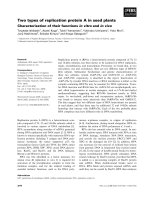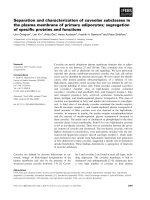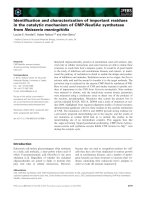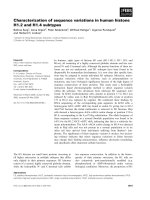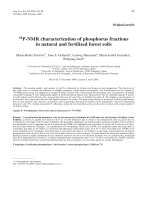Characterization of major metabolites of polymethoxylated flavonoids in Pericarpium Citri Reticulatae using liver microsomes immobilized on magnetic nanoparticles coupled with UPLC/MS–MS
Bạn đang xem bản rút gọn của tài liệu. Xem và tải ngay bản đầy đủ của tài liệu tại đây (1.78 MB, 10 trang )
Lei et al. Chemistry Central Journal (2017) 11:13
DOI 10.1186/s13065-017-0237-9
RESEARCH ARTICLE
Open Access
Characterization of major metabolites
of polymethoxylated flavonoids in Pericarpium
Citri Reticulatae using liver microsomes
immobilized on magnetic nanoparticles
coupled with UPLC/MS–MS
Jun Lei1†, Ying Xue2†, Yi‑Ming Liu3 and Xun Liao3*
Abstract
The peels of citrus fruits (Pericarpium Citri Reticulatae, PCR) have long been used in traditional Chinese medicines
(TCMs). Polymethoxylated flavonoids (PMFs) were found to be the main components present in PCR extracts, but
their metabolism remains unclear which restrain the utilization of this TCM. In the present work, rat liver microsomes
were immobilized on magnetic nanoparticles (LMMNPs) for in vitro metabolic study on the whole PMFs of PCR.
LMMNPs were characterized by transmission electron microscope and Fourier-transform infrared spectrum. The rela‑
tive enzyme binding capacity of LMMNPs was estimated to be about 428 μg/mg from thermogravimetric analysis.
Incubation of LMMNPs with PMFs produced demethylated metabolites of PMFs, six of which were identified by ultra‑
high pressure liquid chromatography–mass spectrometry (UPLC–MS/MS). The 3′-hydroxylated tangeretin (T3) was
detected from the metabolites of tangeretin for the first time, which suggested that 4′-demethylated and 3′-hydroxy‑
lated derivative of tangeretin (3′-hydroxy-5,6,7,8,4′-pentamethoxyflavone, T4) was not only derived from 4′-demethyl‑
ated tangeretin (T2) as previously reported, but also from T3. This is the first investigation of the metabolism of the
whole PMFs, which may shed light on the mechanism of action of PCR.
Keywords: Liver microsome, Magnetic nanoparticles, Metabolism, Polymethoxylated flavonoids,
Pericarpium Citri Reticulatae
Background
The health benefits and economic values of peels from
citrus fruits have been known for over a thousand years,
and they have now been widely used in pharmaceutical, food and cosmetic industries. In traditional Chinese
medicine, the dried ripe pericarps of Citrus reticulata or
its cultivars, namely Pericarpium Citri Reticulatae (PCR,
Chenpi in Chinese) were used to treat chronic diseases,
such as coughing, stomach upset, and skin inflammation
*Correspondence:
†
Jun Lei and Ying Xue contributed equally to this work
3
Chengdu Institute of Biology, Chinese Academy of Sciences,
Chengdu 610041, Sichuan, China
Full list of author information is available at the end of the article
with great medicinal values [1]. Polymethoxylated flavonoids (PMFs) were the major components in PCR
[2–5], and increasing evidence shows that PMFs possess
several protective effects including anti-oxidant, antiinflammation, anti-proliferation, anticancer, cardiovascular protection and so on [6–9]. The planar structures
and the low polarity of PMFs might enhance their permeability to biological membranes, thus endow the PMFs
with high bioavailability [10, 11]. Therefore, PMFs have
attracted increasingly attention in the development of
specialty ingredients for nutraceutical and pharmaceutical industries.
The metabolic study on the active components present
in the herbal extracts is important for understanding the
© The Author(s) 2017. This article is distributed under the terms of the Creative Commons Attribution 4.0 International License
( which permits unrestricted use, distribution, and reproduction in any medium,
provided you give appropriate credit to the original author(s) and the source, provide a link to the Creative Commons license,
and indicate if changes were made. The Creative Commons Public Domain Dedication waiver ( />publicdomain/zero/1.0/) applies to the data made available in this article, unless otherwise stated.
Lei et al. Chemistry Central Journal (2017) 11:13
mechanism of action for the original TCMs. Biotransformation of two PMFs isolated from PCR, nobiletin and
tangeretin, has been investigated both in vitro and in vivo.
In vitro experiments showed that demethylated derivatives were their major metabolites [12–14]. In vivo study
in the mouse revealed that 4′-demethylnobiletin was the
major metabolite of nobiletin [15], while demethylated
and hydroxylated products are the major metabolites for
tangeretin [16]. Despite all those studies on individual
PMFs, there have no reports on the metabolism of the
whole extract of the PCR. Since PCR has been utilized in
the form of mixture like most herbals do, investigation of
the metabolism of its whole extracts can provide more reasonable information in understanding the mechanism of
action.
In this study, we investigated the metabolism of the
whole extracts of PCR by a highly active nanobioreactor prepared by immobilizing rat liver microsomes onto
magnetic nanoparticles (LMMNPs). Magnetic nanoparticles have been widely used as adsorbent to immobilize
biomolecules for the enrichment of natural products due
to the convenience of magnetic solid–liquid separation
[17–19]. Previously, we have developed a similar microsomal nanobioreactor for the in vitro metabolic study of
Rhizoma coptidis extract which exhibited higher activity
and stability than free microsomes [20]. In the present
work, we improved the relative enzyme loading capacity of the microsomal nanobioreactors that greatly facilitated metabolic study on the whole extract of PCR. The
metabolites of PCR extract were characterized by ultrahigh pressure liquid chromatography–mass spectrometry (UPLC–MS/MS), most of which were compared with
those of nobiletin and tangeretin which are the two major
PMFs present in PCR extract.
Experimental
Materials and reagents
Pericarpium Citri Reticulatae was purchased from a local
herbal market. It was authenticated by Professor Xinfeng Gao. A voucher specimen was deposited in Herbaruim of Chengdu Institute of Biology, No. CIBI0064257.
Nobiletin and Tangeretin were purchased from
Chengdu Must Bio-technology Co., LTD (China) and
indentified in our laboratory for qualitative and quantitative analysis. β-naphthoflavone, polydiallyldimethylammonium chloride (PDDA), β-nicotinamide
adenine dinucleotide phosphate hydrate (NADP), glucose-6-phosphate, yeast glucose-6-phosphate dehydrogenase, 4-nitrophenol (PNP) and 4-nitrocatechol (PNC)
were purchased from Sigma (MO, USA). HPLC grade
acetonitrile was purchased from Fisher Scientific (Fisher,
Fair Lawn, USA). Deionized water was purified by a
Milli-Q water system (Millipore Corp., Bedford, MA,
Page 2 of 10
USA). Tetraethyl orthosilicate (TEOS) was purchased
from TCI (Tokyo, Japan). Other chemicals and solvents
were of analytical reagent grade and were obtained from
Chengdu Chemical Factory (Chengdu, China).
Sample preparation
Pericarpium Citri Reticulatae was dried and powdered,
and 1 g of the sample was placed into a 250 mL conical
flask containing 100 mL methanol to be refluxed in water
bath at 90 °C for 1 h. The methanol solution was filtered
and cooled to the room temperature before used. Nobiletin and tangeretin were respectively dissolved in methanol at 1 mg/mL as work solutions.
Rats liver microsomes preparation
Microsomes were prepared from the livers of
β-naphthoflavone treated male Sprague–Dawley rats
according to standard procedures described by Lake [21].
The inductor was dissolved in vegetable oil at 8 mg/mL,
and was intraperitional injected to the rats at a dose of
80 mg/kg once for two days. The rats were sacrificed in
the third day for the microsome preparation. The protein
concentrations of the microsome obtained were estimated by Bradford assay using the bovine serum albumin
(BSA) as standard [22].
Nanobioreactor fabrication
The microsomes were immobilized onto the MNPs
according to the following procedure. MNPs were synthesized by co-precipitation and coated with a layer of
SiO2 using TEOS, and were then dispersed in 2 mg/mL
PDDA for 20 min to distribute a layer of positive change
on the surface. The PDDA-MNPs were dispersed in
microsomes dispersion for 30 min to absorb the liver
microsomes. Finally, an external magnet was used to
separate the resultant magnetic nanoparticles from the
solution to obtain the final bioreactor (LMMNPs). The
sizes and morphologies of magnetic nanoparticles were
recorded using a transmission electron microscope
(TEM, H-600IV, Hitachi Co., Tokyo, Japan). The Fouriertransform infrared spectra (FT-IR) were obtained with
a Perkin-Elmer Spectrum 100 (Waltham, MA, USA).
Thermogravimetric analysis (TGA) was performed for
powdered samples with a heating rate of 10 °C/min1 from
room temperature to 800 °C under nitrogen atmosphere
using a TGA Q500 V20.10 Build 36 thermo analysis system (TA instruments, New Castle, USA).
Metabolism kinetics
The PNP was used as the substrate to compare the enzymatic activity of the LMMNPs with the free microsomes.
When PNP is incubated with the microsomes, the microsomes mediate its hydroxylation to produce PNC. This
Lei et al. Chemistry Central Journal (2017) 11:13
reaction has usually been used to test hepatic activity in
different animal species. In this experiment, PNP was
incubated with LMMNPs and free microsomes respectively to compare the Michaelis constant (Km) and the
maximum rate of the reaction (Vmax), during which the
amount of microsmes immobilized in LMMNPs was
equivalent to that of the free microsomes.
Incubation
Metabolisms of nobiletin, tangeretin and the extract of
Pericarpium Citri Reticulatae were studied by incubating 10 μL work solution of each with 100 μL of bioreactor
dispersion in 0.1 M potassium phosphate buffer (pH 7.4),
and the incubation volume was finally adjusted to 400 μL
containing 10 mM magnesium chloride. The metabolic
reaction was initiated by adding 100 μL of NADPHgenerating solution (1.3 mM NADP, 3.3 mM glucose6-phosphate and 1 U/mL yeast glucose-6-phosphate
dehydrogenase) and incubated at 37 °C for 60 min. The
reaction was terminated by magnetic separation of the
bioreactors from the reaction solution, and the supernatant was filtered though a 0.22 μm membrane and subjected to UPLC–MS/MS analysis. No organic solvent
were added to stop the reaction as do in other enzymatic
reactions, so that the LMMNPs separated can be reused
after washing with potassium phosphate buffer(0.1 M,
pH 7.4) three times (500 μL each time).
Instrumentation
The Waters ACQUITY ultra-performance liquid chromatographic systems (Waters, Milford, PA, USA) used
in this experiment was equipped with a binary pump,
an autosampler, a photodiode array detector, a column
temperature controller and a Waters xevo™ mass Spectrometer with triple-quadrupole MS system. The analytes
were separated on a Waters ACQUITY UPLC BEH C18
column (2.1 × 100 mm, 1.7 μm). Formic acid aqueous
solution (0.1% formic acid, solvent A) and acetonitrile
(solvent B) were used as mobile phase for UPLC separation. The elution condition was as follows: 20% B at
0–1 min, 20–40% B at 1–3 min, 40–95% B at 3–7 min.
The wavelength of PDA detector was set in the range of
200–400 nm. The flow rate was set at 0.2 mL/min and the
peaks were detected at 345 nm. Moreover, the autosampler temperature was kept at 10 °C, and a 1 μL of each
sample was injected for analysis. ESI–MS spectra were
acquired in positive ion mode in the range of m/z 100–
1000 for the full-scan MS analysis. The source parameters
were set as follows: the capillary voltage was 3.25 kV, the
cone voltage was 50 V, the source and desolvation temperatures were set at 100 and 350 °C. Nitrogen was used
Page 3 of 10
as the desolvation gas at a flow rate of 550 L/h, and argon
was used as collision gas at a flow rate of 0.15 mL/min.
Results and discussion
Synthesis and characterization of LMMNP nanobioreactors
Electrostatic adsorption method was applied to prepare
the superparamagnetic nanocomposites. The size of the
magnetic nanoparticles was measured by TEM. Figure 1a shows that the average diameter of the Fe3O4@
SiO2 was about 200 nm, and small protuberances can
be seen at the edges of the nanoparticles of LMMNPs
in Fig. 1b. Moreover, the LMMNP nanoparticle bioreactors accumulated rapidly in solution under magnetic
field and dispersed quickly with a slight shake once the
magnetic field was removed, which indicated that the
LMMNP nano-bioreactors were successfully synthesized.
FT-IR spectra provide further evidence for the successful immobilization of liver microsomes onto the surface
of magnetic nanoparticles. The peak at 1084 cm−1 is
assigned to the silica layer vibrations. The band between
3300 and 3400 cm−1 results from the stretching vibration
of the hydroxyl group. Compared with Fe3O4@SiO2 and
Fe3O4@SiO2@PDDA, the absorption peaks at 2924, 2853,
1647, 1542 and 1457 cm−1 for LMMNPs are ascribable to
the vibrations of the methylene and amide groups, which
belong to side chains of the enzyme on the surface of the
magnetic nanoparticles [23, 24]. The relative enzyme
loading capacity was estimated to be about 428 μg protein/mg MNPs based on the results from the TGA analysis (Fig. 2).
Kinetic constants
Kinetic parameters, the Michaelis constant (Km) and
the maximum rate of the reaction (Vmax) for free and
immobilized rat liver microsomes were assayed using the
PNP as substrate. Km and Vmax were calculated from the
Lineweaver–Bruk plots using the initial rate of the reaction data.
V =
Vmax × [S]
Km + [S]
Km
1
1
1
=
×
+
V
Vmax
[S] Vmax
where [S] is the concentration of the substrate, V and
Vmax represent the initial and the maximal rate of the
reaction, respectively, and Km is the Michaelis constant.
Vmax is defined as the highest possible velocity when all
enzymes are saturated with the substrate, reflecting the
intrinsic characteristics of the immobilized enzymes.
Km is defined as the substrate concentration that yields a
Lei et al. Chemistry Central Journal (2017) 11:13
Page 4 of 10
Fig. 1 TEM images of a Fe3O4@SiO2 magnetic nanoparticles and b LMMNP nanoparticle bioreactors
A
B
C
Fig. 2 TGA analysis of (A) Fe3O4@SiO2, (B) Fe3O4@SiO2@PDDA and (C)
LMMNPs
reaction velocity of 1/2, reflecting the effective characteristics of the enzyme. The values of Km and Vmax were calculated from Lineweaver–Burk plots as shown in Table 1.
The Km for LMMNPs is in the same order with that of
free microsomes, indicating that the enzymatic activity
of LMMNPs was acceptable for the following metabolic
study.
In the mean time, the prepared LMMNPs exhibited
good reusability as we described in our previous paper,
in that it retained its original enzymatic activity after six
rounds of use [20]. Owing to the superparamagnetism of
the LMMNPs, it is very convenient to stop the enzymatic
reaction and separate the bioreactor from the incubation solution by using an external magnet, while at the
Table 1 Km and Vmax for free and immoblized rat liver
microsomes for PNP
Form of microsomes
Km (mM)
Vmax (nM/min/mg)
Free microsomes
0.15
200
LMMNPs
0.45
same time, the supernatant can be directly subjected for
HPLC–MS for analysis of the metabolites.
The metabolite profiling of the extract of Pericarpium Citri
Reticulatae
Polymethoxylated flavonoids such as nobiletin and tangeretin were reported to be the major active components
in PCR, and there have been intensive in vitro studies
on the biotransformation of individual polymethoxylated flavonoids. However, to the best of our knowledge,
no in vitro metabolic study on the whole extract of PCR
has been performed. As there are multiple active components in herbs, in vitro metabolism of individual compounds might not reflect the real fate of the herbs. In this
work, we incubated the PCR extract with LMMNPs in
order to investigate the metabolites of the whole extract.
The UPLC–MS/MS chromatograms obtained from
the incubation solution for 0 and 60 min are shown in
Fig. 3. It was found that the peak areas of peaks 10, 11
and 12 were significantly reduced after metabolization.
These compounds were identified as nobiletin, tangeretin and monohydroxy pentamethoxyflavone according to the retention times, UV absorption spectra and
MS/MS fragments. In addition, several new peaks were
observed between 2.50 and 3.50 min in the 60 min incubation solution. Based on the UV absorption spectra, the
molecular ions [M+H]+ and the MS/MS fragment ions,
these compounds were tentatively identified as dihydroxytetramethoxyflavone ([M+H]+ m/z 375), monohydroxypentamethoxyflavone ([M+H]+ m/z 389) and
monohydroxytetramethoxyflavone ([M+H]+ m/z 359),
respectively [2].
To further verify the structures of the above metabolites, the two major components of the PCR, tangeretin and nobiletin were metabolized respectively with
LMMNPs. The UPLC–UV–MS/MS indicated that
seven metabolites were formed from tangeretin as
shown in Figs. 4a, b and 5a. The three major peaks of
T2, T3 and T4, with molecular masses of 388 ([M+H]+
m/z 389), 358 ([M+H]+ m/z 359) and 374 ([M+H]+
Lei et al. Chemistry Central Journal (2017) 11:13
Page 5 of 10
b
1.0e-1
AU
8.0e-2
6.0e-2
10
7
4.0e-2
6
3
2.0e-2
11
0.0
0.50
1.00
1.50
2.00
2.50
3.00
3.50
4.00
12
4.50
5.00
5.50
6.00
6.50
7.00
5.00
5.50
6.00
6.50
7.00
Time
a
10
1.0e-1
8.0e-2
AU
6.0e-2
11
4.0e-2
2.0e-2
12
7
0.0
0.50
1.00
1.50
2.00
2.50
3.00
3.50
4.00
4.50
Time
Fig. 3 The UPLC analysis of the whole extract of PCR incubation solution a 0 min; and b 60 mmin. Compounds represented by peaks 3–12 are
listed in Table 2
m/z 375), respectively, were tentatively identified as
3′-hydroxy-5,6,7,8,4′-pentamethoxyflavone, 4′-hydroxy5,6,7,8-tetramethoxyflavone and 3′,4′-dihydroxy-5,6,7,8tetramethoxy flavone, according to a previous report on
the metabolism of tangeretin [25]. In this reports, tangeretin was metabolized firstly to 4′-demethylated tangeretin (4′-hydroxy-5,6,7,8-tetramethoxyflavone, T3),
and then a hydroxyl group was added to the C-3′ of T3
to form 3′,4′-dihydroxy-5,6,7,8-tetramethoxy flavone
(T4). Interestingly, 3′-hydroxylated tangeretin (T2) was
detected as the metabolite of tangeretin for the first time,
suggesting a new metabolic pathway in which T4 might
also be transferred via T2. In addition, T1 and T5 had
different retention time but the same molecular mass
with T3 ([M+H]+ m/z 359) and T4 ([M+H]+ m/z 375),
respectively, which indicates that their structures were
similar to T3 and T4. The other two metabolites (T6 and
T7) had the same molecular mass of 344 ([M+H]+ m/z
345) but different retention time, suggesting the loss of
one methyl group at various positions of T3, and they
were tentatively identified as 4′,6-dihydroxy-5,7,8-trimethoxyflavone or 4′,7-dihydroxy-5,6,8-trimethoxyflavone. The proposed metabolic pathway of tangeretin was
shown in Fig. 6a.
Five metabolites were detected for the nobiletin in
UPLC–UV–MS/MS as shown in Figs. 4c, d and 5b. The
molecular masses of the metabolites are m/z 389 (N1, N2
and N3), m/z 375 (N4 and N5), respectively. The major
metabolite N1 was tentatively identified as 4′-hydroxy5,6,7,8,3′-pentamethoxyflavone, which was a 4′-demethylated product of nobiletin. N2 and N3 were tentatively
detected as 6-hydroxy- 5,7,8,3′,4′-pentamethoxyflavone
or 7-hydroxy-5,6,8,3′,4′-pentamethoxyflavone, which
were formed by the loss of one methyl group at 6 or
7 position in nobiletin. N4 and N5 were found to be
the demethylated products of N1 and N2 (or N3),
respectively, which were tentatively identified as
3′,4′-dihydroxy-5,6,7,8-tetramethoxyflavone (N4) or
Lei et al. Chemistry Central Journal (2017) 11:13
a
2.0e-2
AU
Page 6 of 10
TG
1.5e-2
1.0e-2
5.0e-3
0.0
0.50
1.00
1.50
2.00
2.50
3.00
b
2.0e-2
4.00
4.50
5.00
5.50
6.00
5.00
5.50
6.00
TG
T3
1.5e-2
AU
3.50
1.0e-2
5.0e-3
0.50
1.00
1.50
2.00
T2
T4
T6
0.0
2.50
3.00
T1
3.50
4.00
4.50
Time
2.5e-2
c
NB
AU
2.0e-2
1.5e-2
1.0e-2
5.0e-3
0.0
0.50
2.5e-2
1.00
1.50
2.00
2.50
3.00
d
N1
2.0e-2
AU
3.50
4.00
4.50
5.00
5.50
6.00
4.50
5.00
5.50
6.00
NB
1.5e-2
1.0e-2
5.0e-3
N4
0.0
0.50
1.00
1.50
2.00
N3
2.50
N2
3.00
3.50
Time
4.00
Fig. 4 The UPLC chromatograms of tangeretin and nobiletin solutions incubated with LMMNPs: a tangeretin + LMMNPs at 0 min; b tangere‑
tin + LMMNPs at 60 min; c nobiletin + LMMNPs at 0 min; and d nobiletin + LMMNPs at 60 min
6,7-dihydroxy-5,8,3′,4′-tetramethoxyflavone (N5), as
show in Fig. 6b. These results are in agreement with a
previous report on the metabolism of nobiletin catalyzed
by rat liver microsomes [12]. It is worth noting that N4
was identical to T4 based on the retention time, molecular mass and UV absorption.
From the above description, it is obvious that the
major metabolites of PCR extract were the same with
those of nobiletin and tangeretin. However, in the HPLC
chromatogram of the PCR extract metabolites, complicated cases happened in which different parent compounds produced the same metabolite. For example, T4
was identical to N4 (Fig. 6), while this metabolite can be
derived from both tangeretin and nobiletin. On the other
hand, a metabolite could be identical to a compound
originally present in the extract, as is the case of peak 7
(Fig. 3). The metabolite profile of the extract of PCR is
summarized in Table 2.
Lei et al. Chemistry Central Journal (2017) 11:13
Page 7 of 10
a
TG
m/z 373
%
90
-10
0.50
1.00
1.50
2.00
2.50
3.50
3.00
90
4.50
5.00
5.50
1.00
1.50
2.00
2.50
3.50
3.00
4.00
4.50
5.00
5.50
T2
6.50
7.00
6.00
6.50
7.00
6.50
7.00
6.50
7.00
6.50
7.00
6.50
7.00
6.50
7.00
6.50
7.00
6.50
7.00
6.50
7.00
m/z 389
%
90
6.00
m/z 359
T1
%
-10
0.50
4.00
T3
-10
0.50
1.00
1.50
2.00
2.50
90
1.00
1.50
2.00
2.50
T7
%
90
-10
0.50
3.00
3.50
4.00
4.50
5.00
5.50
1.00
1.50
3.00
T6
2.00
3.50
4.00
4.50
5.00
5.50
2.50
3.00
3.50
4.00
4.50
5.00
5.50
%
1.00
1.50
2.00
2.50
3.00
3.50
b
4.00
4.50
5.00
5.50
NB
1.50
2.00
2.50
%
N3
1.00
1.50
2.00
%
0.50
2.50
1.00
1.50
2.00
N2
3.00
3.50
N1
3.50
4.00
4.50
5.00
5.50
2.50
6.00
m/z 389
4.00
4.50
5.00
5.50
N4
N5
90
-10
3.00
6.00
m/z 403
%
1.00
90
-10
0.50
6.00
TIC
90
-10
0.50
6.00
m/z 345
90
-10
0.50
6.00
m/z 375
T5
%
-10
0.50
T4
6.00
m/z 375
3.00
3.50
4.00
4.50
5.00
5.50
6.00
TIC
%
90
-10
0.50
1.00
1.50
2.00
2.50
3.00
3.50
4.00
4.50
5.00
5.50
6.00
Fig. 5 UPLC–MS chromatograms from the incubation solution at 60 min. a Tangeretin; b nobiletin
Conclusion
Liver microsomes immobilized on magnetic nanoparticles are proven to be reusable and very effective for
in vitro metabolic studies. Thanks to the superparamagnetic property of these bioreactors, isolation of enzymes
from the metabolic solution can be easily achieved by
using an external magnet, avoiding tedious sample pretreatment such as centrifugation, filtration and evaporation which are normally required for metabolite analysis.
Using the proposed nanobioreactors, in vitro metabolism of the whole extract of Pericarpium Citri Reticulatae was investigated in this work for the first time.
Polymethoxylated flavonoids present in the extract and
their metabolites were identified by UPLC–UV–MS/
MS. Three polymethoxylated flavonoids in the PCR
whole extract, i.e. nobiletin, tangeretin and monohydroxy pentamethoxyflavone were effectively metabolized by the LMMNPs bioreactors. Six metabolites, i.e.
Lei et al. Chemistry Central Journal (2017) 11:13
Page 8 of 10
a
HO
T1
m/z 359
O
O
O
7
6 A
5
O
8
9
O
C
2'
2 1'
4
3
3'
B
O
O
4'
O
5'
O
6'
OH
O
O
O
O
O
HO
O
T3
m/z 359
Tangeretin
m/z 373
O
O
O
O
O
O
O
O
O
HO
O
O
O
O
O
OH
O
O
T6/7
m/z 345
O
O
O
O
O
O
O
O
OH
OH
O
O
O
O
O
or
O
HO
O
O
O
O
O
N2/N3
m/z 389
O
O
OH
O
O
N4(=T4)
m/z 375
N1
m/z 389
O
OH
T5
m/z 375
O
O
O
O
O
O
T4(=N4)
m/z 375
T2
m/z 389
O
O
O
O
O
O
Nobiletin
m/z 403
O
O
OH
OH
OH
b
O
O
O
HO
HO
O
O
O
O
O
N5
m/z 375
Fig. 6 The proposed metabolic pathways of tangeretin (a) and nobiletin (b)
3′,4′-dihydroxy-5,6,7,8-tetramethoxyflavone,4′-hydroxy5,6,7,8-tetramethoxyflavone,
4′-hydroxy-5,6,7,8,3′pentamethoxyflavone,
3′-hydroxy-5,6,7,8,4′-penta
methoxyflavone, 6-hydroxy-5,7,8,3′,4′-pentamethoxyflavone/7 -hydroxy-5,6,8,3′,4′-pentamethoxyf lavone
and dihydroxy tetramethoxyflavone were tentatively
identified from the metabolites mixture. Among them,
3′-hydroxy- 5,6,7,8,4′-pentamethoxyflavone was identified as the metabolite of a polymethoxylated flavonoid for
the first time. This finding provides the first evidence that
microsomal metabolism of polymethoxyflavones produce
Lei et al. Chemistry Central Journal (2017) 11:13
Page 9 of 10
Table 2 The compounds identified in incubation solutions at 0 min (M0) and 60 min (M1), respectively
Peaks
tR (min)
M0 [M+H]+
M1 [M+H]+
MS2
Identification
1
2.59
–
375
345
Di hydroxy tetramethoxyflavone
2
2.63
–
375
345
Di hydroxy tetramethoxyflavone
3
2.81
–
375
345, 331, 301
3′,4′-di hydroxy-5,6,7,8- tetramethoxy-flavone
4
3.16
–
389
359, 374, 341
6-hydroxy-5,7,8,3′,4′-pentamethoxy-flavone or
7-hydroxy-5,6,8,3′,4′-pentame-thoxyflavone
6
3.25
–
359
329
4′-hydroxy-5,6,7,8- tetramethoxyflavone
7
3.33
389
389
359, 374, 341
4′-hydroxy - 5,6,7,8,3′-pentamethoxyfla-vone or
3′-hydroxy- 5,6,7,8,4′-pentame-thoxyflavone
8
3.53
373
373
343, 312
Pentamethoxyflavone
9
3.60
359
359
329
Monohydroxy-tetramethoxyflavone
10
3.88
403
403
373
Nobiletin
11
4.25
373
373
343, 325
Tangeritin
12
4.53
389
389
359, 341, 374
Monohydryoxy- pentamethoxyflavone
not only 4′-demethylated as documented in previous literatures, but also 3′-hydroxylated metabolites.
Abbreviations
PCR: Pericarpium Citri Reticulatae; PMFs: polymethoxylated flavonoids; TCM:
traditonal Chinese Medicine; LMMNPs: rat liver microsomes were immobi‑
lized on magnetic nanoparticles; UPLC–MS/MS: ultrahigh pressure liquid
chromatography–mass spectrometry; PDDA: polydiallyldimethylammonium
chloride; NADP: β-nicotinamide adenine dinucleotide phosphate hydrate;
PNP: 4-nitrophenol; PNC: 4-nitrocatechol; TEOS: tetraethyl orthosilicate; TEM:
transmission electron microscope; FT-IR: Fourier-transform infrared spectra;
TGA: thermogravimetric analysis.
3.
4.
5.
6.
Authors’ contributions
XL conceived and designed the experiments. JL and YX performed the experi‑
ments and analyzed the data. YL analyzed the data and wrote the paper. YX
and XL wrote the paper. All authors read and approved the final manuscript.
7.
Author details
Institute of Chemistry and Chemical Engineering, Mianyang Normal Univer‑
sity, Mianyang 621000, China. 2 Sichuan Centre for Disease Control and Pre‑
vention, Chengdu 610041, China. 3 Chengdu Institute of Biology, Chinese
Academy of Sciences, Chengdu 610041, Sichuan, China.
9.
8.
1
Acknowledgements
Financial support from the National Science Foundation of China (No.
81173536), the State Key Laboratory of Phytochemistry and Plant Resources in
West China (No. P2015-KF12), and the West Light Foundation of the Chinese
Academy of Sciences is gratefully acknowledged.
Competing interests
The authors declare that they have no competing interests.
Received: 14 November 2016 Accepted: 4 January 2017
10.
11.
12.
13.
14.
References
1. Chinese Pharmacopoeia and Commission (2010) Pharmacopoeia of the
People’s Republic of China. China Medical Science Press, Beijing, p 191
2. Zhang JY, Zhang Q, Zhang HX, Ma Q, Liu JQ, Qiao YJ (2012) Char‑
acterization of polymethoxylated flavonoids (PMFs) in the peels of
‘Shatangju’ mandarin (Citrus reticulata Blanco) by online high-perfor‑
mance liquid chromatography coupled to photodiode array detection
15.
16.
and electrospray tandem mass spectrometry. J Agric Food Chem
60:9023–9034
Asikin Y, Taira I, Teranoto SI, Sumi H, Ohta H, Takara K, Wada K (2012) The
composition of volatile aroma components, flavanones, and polymeth‑
oxylated flavones in shiikuwasha (Citrus depressa Hayata) peels of differ‑
ent cultivation lines. J Agric Food Chem 60:7973–7980
Zheng GD, Zhou F, Jiang L, Yang DP, Yang X, Lin LW (2010) Isolation and
purification of polymethoxylated flavonoids from Pericarpium Citri Reticu‑
latae by high-speed counter-current chromatography. Chin Tradit Herb
Drugs 41:52–55
Hamdan D, Ei-Readi MZ, Tahrani A, Herrmann F, Kaufmann D, Farrag N,
Ei-Shazly A, Wink M (2011) Chemical composition and biological activity
of Citrus jambhiri Lush. Food Chem 127:394–403
Hirano T, Abe K, Gotoh M, Oka K (1995) Citrus flavone tangeretin inhibits
leukemic HL-60 cell-growth partially through induction of apoptosis with
less cytotoxicity on normal lymphocyte. Br J Cancer 72:1380–1388
Kawaii S, Tomono Y, Katase E, Ogawa K, Yano M (1999) Effect of citrus
flavonoids on HL-60 cell differentiation. Anticancer Res 19:1261–1269
Manthey JA, Bendele P (2008) Anti-inflammatory activity of an orange
peel polymethoxylated flavone, 3′,4′,3,5,6,7,8-heptamethoxyflavone, in
the rat carrageenan/paw edema and mouse lipopolysaccharide-chal‑
lenge assays. J Agric Food Chem 56:9399–9403
Kurowska EA, Manthey JA (2004) Hypolipidemic effects and absorption of
citrus polymethoxylated flavones in hamsters with diet-induced hyper‑
cholesterolemia. J Agric Food Chem 52:2879–2886
Nielsen SE, Breinholt V, Cornett C, Dragsted LO (2000) Biotransformation
of the citrus flavone tangeretin in rats. Identification of metabolites with
intact flavane nucleus. Food Chem Toxicol 38:739–746
Manthey JA, Guthrie N (2002) Antiproliferative activities of citrus
flavonoids against six human cancer cell lines. J Agric Food Chem
50:5837–5843
Koga N, Matsuo M, Otha C, Haraguchi K, Matsuoka M, Kato Y, Ishii T, Yano
M, Ohta H (2007) Comparative study on nobiletin metabolism with liver
microsomes from rats, guinea pigs and hamsters and rat cytochrome
P450. Biol Pharm Bull 30:2317–2323
Murakami A, Kuwahara S, Takahashi Y, Ito C, Furukawa H, Ju-ichi M,
Koshimizu K (2001) In vitro absorption and metabolism of nobiletin, a
chemopreventive polymethoxyflavonoid in citrus fruits. Biosci Biotechnol
Biochem 65:194–197
Breinholt VM, Rasmussen SE, Brosen K, Friedberg TH (2003) In vitro
metabolism of genistein and tangeretin by human and murine
cytochrome p450s. Pharmacol Toxicol 93:14–22
Kong WJ, Li ZL, Xiao XH, Zhao YL (2010) Quality control for Coptidis rhizoma through the determination of five alkaloids by HPLC-ELSD coupled
with chemometrics. Nat Prod Res 24:1616–1629
Ren LL, Xue XY, Zhang FF, Xu Q, Liang XM (2007) High performance liquid
chromatography–mass spectrometry analysis of protoberberine alkaloids
in medicine herbs. J Sep Sci 30:833–842
Lei et al. Chemistry Central Journal (2017) 11:13
17. Qing LS, Xue Y, Liu YM, Liang J, Xie J, Liao X (2010) Rapid probe and
isolation of bioactive compounds from Dioscorea panthaica using
human serum albumin functionalized magnetic nano-particles (HSA–
MNPs)-based ligand fishing coupled with electrospray ionization mass
spectrometry. Rapid Commun Mass Spectrom 24:3335–3339
18. Ren XY, Xue Y, Liang J, Ding LS, Liao X (2013) Selective extraction of flavo‑
noids from Ginkgo biloba leaves using human serum albumin functional‑
ized magnetic nanoparticles. Chin Chem Lett 24:1099–1102
19. Qing LS, Xiong J, Xue Y, Liu YM, Guang B, Ding LS, Liao X (2011) Using
baicalin-functionalized magnetic nanoparticles for selectively extracting
flavonoids from Rosa chinensis. J Sep Sci 34:3240–3245
20. Xue Y, Xiong J, Shi HL, Liu YM, Qing LS, Liao X (2013) In vitro metabolic
study of Rhizoma coptidis extract using liver microsomes immobilized on
magnetic nanoparticles. Anal Bioanal Chem 405:8807–8817
Page 10 of 10
21. Lake BG (1987) Preparation and characterization of microsomal fractions
for studies on xenobiotic metabolis. In: Mullock B, Snell K (eds) Biochemi‑
cal toxicology: a practical approach. IRL Press, Oxford, p 183
22. Bradford MM (1976) A rapid and sensitive method for the quantitation
of microgram quantities of protein utilizing the principle of protein-dye
binding. Anal Biochem 72:248–254
23. Muthirulan P, Velmurugan R (2011) Direct electrochemistry and electro‑
catalysis of reduced glutathione on CNFs–PDDA/PB nanocomposite film
modified ITO electrode for biosensors. Colloids Surf B 83:347–354
24. Wang SM, Su P, Huang J, Wu WJ, Yang Y (2013) Magnetic nanoparticles
coated with immobilized alkaline phosphatase for enzymolysis and
enzyme inhibition assays. J Mater Chem B 1:1749–1754
25. Nielsen SE, Breinholt V, Justesen U, Cornett C, Dragsted LO (1998) In vitro bio‑
transformation of flavonoids by rat liver microsomes. Xenobiotica 28:389–401

